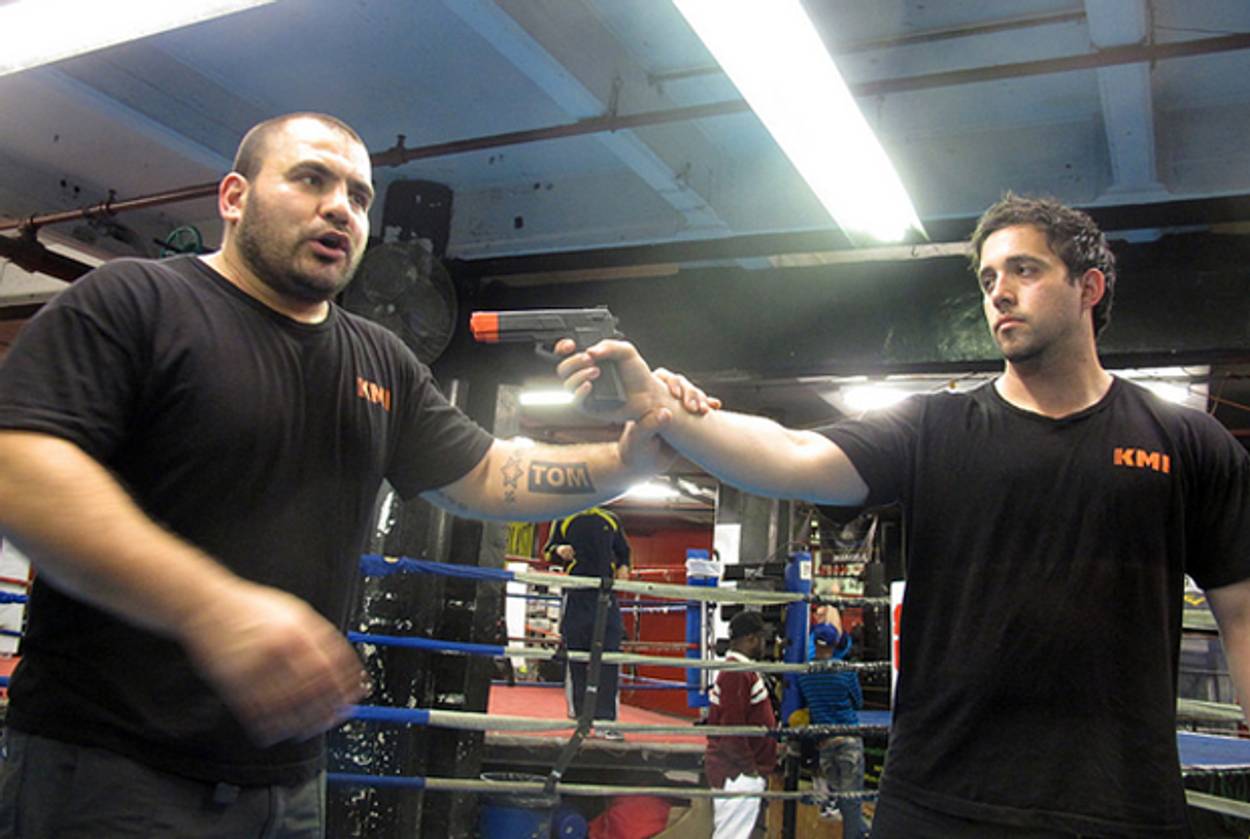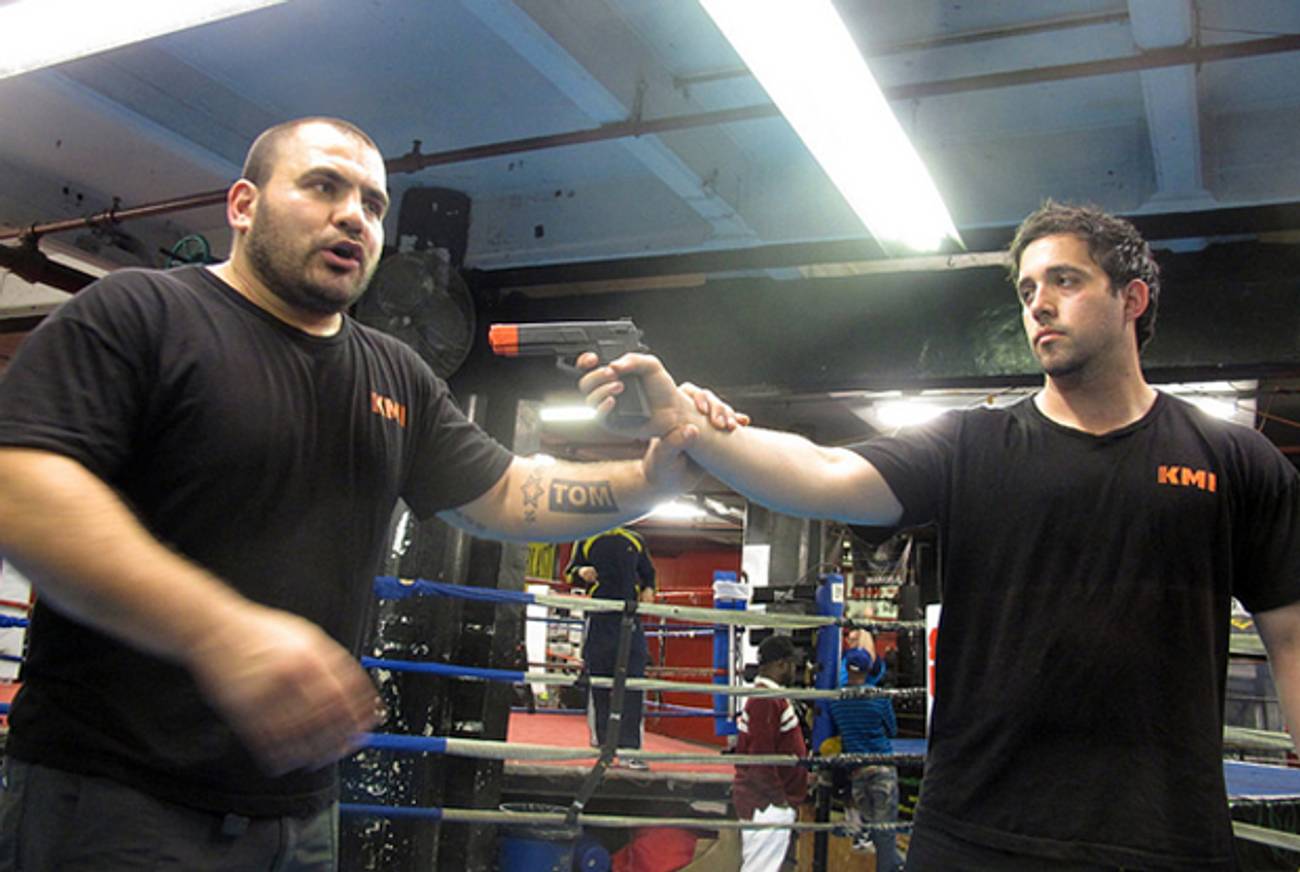What You Learn From IDF Krav Maga Masters
A violent kick to the groin and a punch to the back of the head, then lights out




Last Thursday, Ran Nakash, former Chief Commander of the Israeli Defense Forces’ Krav Maga division, strolled through Brooklyn’s Dumbo neighborhood, wearing a shirt that said, “Bones Heal but Glory is Forever.” The shaved-headed, tattooed Israeli stopped at a door displaying two posters: one of a young blonde woman biting an attacker in the arm; the other of his own face, half covered in shadow, looking fearless while thwarting a knife attack.
Nakash, 35, who’d flown in from Tel Aviv along with head IDF Krav Maga instructor Itay Danenberg, walked up a dingy stairwell into Gleason’s, the famous gym. Barrel-chested with a massive neck, Nakash—also a pro boxer whose career record is 26-1 with 18 knockouts—was recognized by boxers, who stopped their workouts to greet him. Hector Roca, the legendary Panamanian trainer who mentored Hilary Swank for Million Dollar Baby, offered a hug.
Nakash and Danenberg are in New York to lead seminars at Gleason’s and, tonight, at the 92nd Street Y on Krav Maga, the official method of self-defense and hand-to-hand combat for the IDF. Their other clients include the U.S. Navy Seals, Green Berets, and Special Forces from several militaries, including Germany’s, where they were last month.
The purpose of Krav Maga is simple: stay alive by any means necessary. When in danger, incapacitate your attacker quickly by targeting his weak points: a knee to the groin, a strike to the throat or back of the head, a gouging of the eyes. Unlike in boxing or martial arts, nothing is off limits. “Do whatever you want,” Nakash told me. “In this room if someone attacks you, use the chair. Break the chair on his head.”
The three of us sat down on rusty folding chairs in a white, windowless room. “If someone attacks you with a knife, with an ax, with a baseball bat, or somebody wants to stab you,” Nakash said, “it’s a problem.”
“Okay, got it,” I replied.
“Get up,” Danenberg ordered. I did as I was told. “Boom! To the groin.” My future flashed before my eyes. Luckily he didn’t strike. “From here,” he continued, “You’re going to fall down and I can do whatever I want. That’s it. This is the situation.”
“In Krav Maga there’s no referee,” Nakash added.
When they were finished, they walked downstairs, hailed a cab, and disappeared for several hours. Just before sundown, they returned. Standing inside a boxing ring, they set three weapons onto the canvas: a big stick, a knife, and a gun. (Just toys.) About 10 people, mostly boxers and people associated with the gym, stood on the canvas just outside the ropes, taking in this frightening yet exhilarating spectacle. Among the observers were boxer Alicia “Slick” Ashley, the current WBC world champion, and a clean-cut man in his 30s wearing a button-down shirt tucked into slacks, watching intently and asking questions. It was Yuri Foreman, the former WBA boxing champion, who is training for an upcoming HBO bout at Madison Square Garden.
With lethal precision—accompanied by grunts of Ah! Ah! Ah!—they demonstrated how to defend against each weapon. Most scenarios ended with a violent kick or knee to the groin and punch to the back of the head. “Lights out,” Nakash said with a smile.
Previous: Meet The Orthodox Rabbi Who’s Also A Mixed Martial Arts Fighter
Krav Maga Is the New Tae Kwan Do
Related: The Good Fight
Louie Lazar is a journalist living in New York. His work has appeared in the New York Times, the Wall Street Journal, Grantland, and the Jerusalem Post.